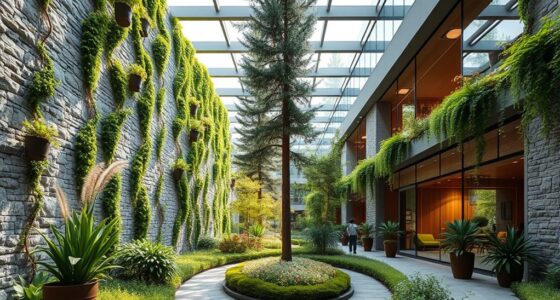Timber construction actively sequesters carbon by storing it within the wood structure throughout a building’s lifespan. When harvested sustainably, trees are replanted and managed responsibly to guarantee forest health and biodiversity. Compared to steel or concrete, timber requires less energy to produce and acts as a natural carbon sink. Plus, timber can be reused or recycled, supporting a circular economy. Keep exploring to discover how these practices make timber a key tool in fighting climate change.
Key Takeaways
- Timber construction sequesters carbon by storing it within wood structures during the building’s lifespan.
- Using timber reduces carbon emissions compared to steel and concrete manufacturing.
- Forest management ensures sustainable harvesting, maintaining forests’ ability to act as carbon sinks.
- Reusing and recycling timber extends its carbon storage benefits, supporting a circular economy.
- Timber’s natural carbon storage ability helps mitigate climate change and promotes sustainable building practices.

Timber construction offers a sustainable way to build structures while actively helping to reduce carbon emissions. When you choose timber, you’re supporting practices like sustainable harvesting, which guarantees that forests are managed responsibly to meet current needs without compromising the health of the ecosystem. This approach means trees are harvested at a rate that allows forests to regenerate naturally, maintaining biodiversity and forest resilience. By focusing on sustainable harvesting, you contribute to a cycle where the timber’s lifecycle begins with careful planning and responsible management, ensuring that each tree cut down is replaced through replanting or natural growth. This cycle promotes long-term forest health, making timber a renewable resource rather than a finite one.
Understanding the timber lifecycle is key to appreciating how timber construction benefits the environment. From planting to harvesting, processing, and eventually recycling or disposal, each stage is a part of a carefully managed process that minimizes waste and maximizes carbon storage. As trees grow, they absorb carbon dioxide from the atmosphere, storing it within their wood structure. When you use timber in construction, you’re effectively locking that carbon away for the lifespan of the building, which can be decades or even centuries. Unlike concrete or steel, which require significant energy to produce and release carbon during manufacturing, timber acts as a natural carbon sink. This ongoing process helps to offset emissions from other sectors, making timber a climate-friendly choice.
Throughout its lifecycle, timber remains a versatile and durable material that can be reused, repurposed, or recycled, further extending its contribution to sustainability. When buildings reach the end of their life, the timber can often be reclaimed and used in new projects or processed into renewable products, reducing the need for virgin timber and lowering the environmental impact. This circular approach supports a low-carbon economy, where materials are kept in use for as long as possible. Additionally, advances in sustainable forestry techniques and better management practices ensure that timber harvesting supports healthy forests rather than depleting them. As a result, you can feel confident that using timber in construction aligns with global efforts to combat climate change while promoting economic and ecological sustainability.
Furthermore, promoting sustainable forestry techniques helps ensure that timber harvesting continues to support healthy ecosystems and resilient forests for future generations.
Frequently Asked Questions
How Does Timber Compare to Concrete in Long-Term Carbon Storage?
Timber outperforms concrete in long-term carbon storage because sustainable forestry guarantees trees absorb CO2 during growth, reducing overall emissions. When you choose timber, you’re supporting a positive carbon lifecycle, where stored carbon remains locked in the wood for decades. Concrete, on the other hand, releases significant CO2 during production, making it less sustainable. Your choice of timber helps lower your carbon footprint and promotes environmentally friendly building practices.
What Are the Environmental Impacts of Harvesting Timber Sustainably?
You might think harvesting timber sustainably is just a walk in the park, but it’s actually a superhero move for the environment. By promoting reforestation benefits and preserving biodiversity, sustainable harvesting guarantees forests stay healthy and resilient. This approach minimizes habitat loss, prevents erosion, and supports wildlife. So, you’re not just taking wood; you’re actively contributing to a balanced ecosystem, proving that eco-friendly choices can be both smart and stylish.
Can Old Timber Buildings Effectively Sequester Carbon Today?
Yes, old timber buildings can effectively sequester carbon today. By preserving these structures for heritage reasons, you maintain their structural integrity and prevent the release of stored carbon. Keeping them intact reduces the need for new construction and minimizes environmental impact. Your efforts in heritage preservation not only protect cultural history but also serve as a natural carbon sink, contributing positively to climate change mitigation.
How Does Timber Construction Influence Urban Heat Island Effects?
Imagine a city dressed in a green cloak—timber construction actively reduces urban heat island effects. By providing urban shading, timber materials block direct sunlight, lowering surface temperatures. Additionally, timber’s natural insulation properties help retain coolness inside buildings, reducing reliance on air conditioning. This combination creates a cooler, more comfortable environment, proving that timber’s sustainable qualities extend beyond construction to transform urban climates for the better.
Are There Innovative Timber Products That Enhance Carbon Storage?
Yes, innovative timber products like cross-laminated timber (CLT) and mass timber enhance carbon storage by sequestering CO₂ during manufacturing and use. These products actively lock in carbon, reducing overall emissions. You can incorporate such materials into your projects to boost carbon enhancement efforts. They not only provide structural benefits but also contribute to climate goals by storing carbon long-term, making your buildings more sustainable and environmentally friendly.
Conclusion
By choosing timber construction, you harness nature’s own archive of carbon, much like the ancient forests that inspired legend. Your decision not only builds a sustainable future but also echoes the timeless wisdom of the earth’s first architects. As with the enduring stories of the woods, your efforts contribute to a legacy of balance and renewal, proving that by respecting nature’s blueprint, you can make a lasting impact—one that whispers of harmony and hope for generations to come.










